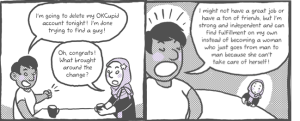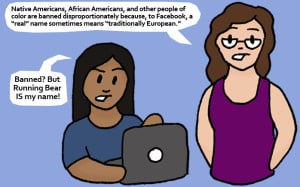
A smiling family of four stand in front of their house, holding recycling bins.
What if I told you that you are capable of saving hundreds of gallons of water, being a better advocate for our planet, and shaving possibly hundreds of your hard-earned dollars off your electric and water bills every year?
Yes, you, with your hair in some sweet new type of three-second bun, trying to find the keys you swore your toddler couldn’t reach that are now probably cuddling with last month’s lost socks.
I have found that when it comes to environmental concern, you either get no regular media coverage – as little as 1.2% between 2011 and 2012, so good luck catching whatever they’re showing – or you get smothered by disaster after disaster while trying to inform yourself.
Either way, we end up feeling powerless or like destruction personified.
However, you can find much solace in the fact that there are plenty of warriors doing wonderful work, and that after a ban on a specific chemical in 1989, statistics are now showing that the damage to our ozone layer can shrink (albeit slowly).
While there’s no getting around the fact that the way most humans in the developing world exist is detrimental to the planet, there are multiple ways we can do our part to save the environment starting immediately, without breaking the bank or completely disturbing our routines and lifestyles.
Adopting a few fresh habits in these five categories will greatly benefit your impact on the environment.
1. Transportation
While the hole in the ozone may be healing itself, we still have a huge responsibility to limit our greenhouse gas emission levels. This calls for a serious analytical look at our everyday transportation routines.
We all obviously can’t afford to go out and buy a Tesla or Prius. But there are tons of little things to think about that can really make a dent in this issue.
If biking or walking to work or school is not an option, reach out to coworkers, classmates, and fellow parents to plan a carpool schedule.
Even one car off the road impacts those emissions. There are plenty of apps and services available to help you make this shift.
Positive shifts are happening behind the scenes in the public transportation field, too, thanks to the GROW America Act.
Pay attention to your “to-do”s and combine as many errands into one trip as possible.
Try never to leave your car running if you aren’t actually going anywhere – think bank lines, keeping your car running for heat or AC, and so on.
According to various sources, idling for just ten seconds burns more fuel and money than restarting your engine.
I recently found an article about the substantial benefits of online shopping with statistics that blew me away. According to the study referenced throughout the article, “Approximately 65% of total emissions generated by the traditional retail model stemmed from customer transport to and from retail stores.”
So while it’s important to consider how you’ll dispose of the packaging (reduce, reuse, recycle, donate), think of the lines and chaos skipped, gallons of gas saved, and tons of harmful gas not emitted by shopping online!
The 2016 Living Planet Report summary mentions the abundance-civilization-destruction-restoration cycle of China’s Loess Plateau, which is symbolic of any place in which humans become the dominant species.
“The crucial step toward restoration was the understanding that, in the long run, safeguarding ecosystem functions is vastly more valuable than the production and consumption of goods and services.”
We can and must be better.
2. Electricity Usage
We broke records in 2015 by using more clean, renewable energy than coal-based. India stepped up big time, both by officially joining the Paris climate agreement and by turning on a solar panel set so large it will have the capacity to “provide energy for 150,000 homes.”
Pope Francis spoke about environmental awareness being human responsibility, and his words swayed 3,500 churches to the green side.
This is certainly grounds for celebration, but it doesn’t mean we’re in the clear.
Energy-efficiency can work with your budget, so it isn’t always about emptying your wallet on special appliances (though they can save 30-80% on energy bills when used properly) or the installation of solar panels.
From choosing more efficient bulbs the next time you need replacements to closing air vents in less-frequented rooms, these little shifts add up. Take a few minutes before leaving the house to be sure all lights are off. Only run the dishwasher and laundry machines when they’re full.
Do a home energy audit to discover areas where you can save money. Find out how much energy your home uses with an energy savings calculator like this one, or use one of these nifty kilowatt meters to determine what’s costing the most.
According to a 2015 article, furnaces and hot water heaters draw about 20% of the energy used in homes.
Become good friends with your thermostat, and make sure any window, vent, and duct seals are sound. Choose more or less clothing over relying on the heat/AC whenever possible. Wash clothes in cold water, and try to not let water just run down the drain because it hasn’t reached a temperature to which you’re accustomed.
This silly video is full of surprising facts, including just how much America spends annually on “vampire” devices that are plugged in but not in use (spoiler alert, it’s over $1 billion). So unplug what you’re not using, or utilize a power strip.
So many of our choices should take supply and demand into consideration.
You’ve heard the saying, “We vote with our money.” If we keep paying what we pay and not making conscious choices and progressive changes, we are creating the demand for more “dirty” energy.
3. Water Usage
Because any mandated water restrictions are state-specific and few and far between, we never really need to view water as finite or precious. (Our toilets are filled with cleaner water than many countries have to drink. Think about that for a moment.)
A shift in our perspectives, both collectively and individually, is necessary for a smooth transition.
Everyone is familiar with turning the faucet off while washing hands, brushing teeth, and doing dishes. Also, there are many home appliances now – toilets, washing machines, faucets – that are substantially more water-efficient than they used to be.
But did you know that shortening your shower by just one minute can save around 550 gallons a year? Or that Americans could save upwards of $2.2 billion and $2.6 billion in water bills and energy bills for heating water, respectively, just by switching to a more efficient shower head?
I’ve adjusted my shower routine so that I usually only have the water running to dampen and rinse. I turn it off completely while lathering and scrubbing.
Making a monthly effort to check all sources for leaks can go a long way, too, considering the average family’s household loses large amounts of water this way annually.
We are literally pouring our money and precious resources down the drain.
Let’s set a better example for our little ones by learning with them.
4. Disposable Items
We have come a long way in the field of waste management (California’s killing it). From farming to fashion, people have become more innovative (like this app that takes your pictures of litter and feeds it to companies to promote sustainability) and efficient in their quest to take care of the planet. Many countries have implemented incineration as a way to turn their garbage into energy.
Individuals have been taking strides as well, like this group that picked up four million pounds of trash collected by the tides along the coast of India.
In the US, we pay for convenience.
While statistics show that packaging waste dropped 6% between 1994 and 2012, most products still come tailored to the needs of the busy. (Of course, we must keep in mind that many of products that seem to be marketed to “busy,” “lazy,” or “stupid” people are actually extremely valuable for disabled folks.)
Earlier this week, I passed on a five-dollar container of pre-cut cantaloupe and instead bought a whole cantaloupe that had almost twice the amount of fruit than the container and was two dollars cheaper.
Spending ten minutes cutting the fruit myself resulted in more nutrients in my diet, more money in my bank account, and less plastic waste. And those are just the repercussions of a single choice.
We need to put our money where our collective mouth is, when we’re able to.
The average family of four would save thousands of dollars per year switching from bottled water to reusable bottles and a filtration system.
Try to reduce the number of new things you buy (especially things that are non-reusable), and if you must buy new/disposable products, look for ones that are reusable and sustainable.
Say no to – or at least reuse – plastic to-go utensils. Turn down or bring your own drinking straws (500 million are thrown away every day) and cups while you’re out.
Give excess packing material to your local post office or UPS for them to reuse.
Always have reusable bags handy for that last-minute trip to Walgreens. Shop from farmer’s markets or community gardens, when possible. Bring your own produce bags (or keep the paper/plastic ones you get from your grocery store) and containers from home.
Consider switching from disposable pads and tampons – 20 billion of which are discarded annually in North America alone – to reusable cloth pads or a menstrual cup. If you’re up for the challenge (see #7 and 8 here), cloth diapers are eco-conscious – and really cute – as well.
Opt out of junk mail, and look for a paperless option for your bills.
The possible shifts in this category are practically endless, and every step forward counts. Don’t be overwhelmed; having more options makes the goal much more attainable!
Again, when we reduce the demand for these harmful products, we take our power back.
I know we’re not all ready to marry our local bulk bins or commit to a zero-waste lifestyle (that’s my favorite video on this topic, by the way).
Ultimately, every one of us must decide to care about the trash we make. Conscious choices breed better circumstances.
5. Chemicals
There is a plethora of scary statistics about the chemicals we often use in our homes. (This list is particularly damning, but the information is sourced and extremely important. Read with a mind open and ready to change – and some form of comfort on standby.)
It’s important to take control of this area as individual consumers, because the majority of the chemicals we have access to have not been tested for human toxicity.
The EPA is not required to, and therefore cannot, test a chemical for potential risks unless a risk becomes likely to occur. The chlorofluorocarbon ban in the ‘80s helped immensely with the aforementioned shrinkage of the ozone layer.
Fortunately, there are so, so, so many different ways to combat all of this toxicity.
Access to green alternatives for anything you need is becoming more readily available and more cost effective (to possibly make your own) all the time.
This is a point where education becomes vital (thanks, WikiHow). Approach this change with care, as it is important that anything you decide to throw away is disposed of properly, in the right places. I don’t even want to think about how many mistakes I’ve made in the past by throwing some random cleaning solution in the garbage.
I know better now, so I do better.
If disposal directions are not listed, this website can help you find a disposal location in the US and Canada. You should be able to contact your local waste management facility wherever you live to find out the safest ways to get rid of toxic waste.
Remember that everything you put in and on your body always ends up somewhere else. Check for the three Ps: petroleum (-derived ingredients), pesticides, and preservatives when shopping for food, makeup, personal hygiene products, and anything else that may come into contact with your body and eventually the earth.
Don’t fret about the choices you made in the past.
Be excited to make better choices starting now!
***
We have the wonderful gift of being able to teach future generations how to live sustainably.
These changes vary in cost and impact, but they are all worth examining to protect your family and our planet. Everything can be implemented as you naturally need it.
Everyone is capable of helping. We hold so much power as consumers.
Revisiting the Living Planet Report summary, I will end with some thoughts about changing our way of thinking:
A prerequisite for effecting significant change in human systems is to understand the nature of the decision-making that results in environmental, social and ecological degradation.
Most decision-making happens after a significant event occurs. But that is not the best place to start when problem-solving, because that is not the problem. The event is a product of the problem.
We must dig to the most basic levels of our society – our “mental models” or belief systems. What do we really value? What do we really fight for or against?
These constructs are what pave the way for systems and guidelines to be set, and eventually lead to the disastrous events that we end up experiencing.
Big, beautiful changes are happening and will continue to do so; but if we don’t look at these issues at their sources, our children and grandchildren will just be applying Band-Aids over ozone holes.
[do_widget id=’text-101′]
Jodie Zoll is a licensed massage therapist working out of New Orleans. She is a lifelong student and animal lover who enjoys singing and baking. Jodie has a long-term goal to spread the importance of self-care, general awareness, and reciprocity.
Search our 3000+ articles!
Read our articles about:
Our online racial justice training
Used by hundreds of universities, non-profits, and businesses.
Click to learn more
Most Read Articles
- « Previous
- 1
- …
- 30
- 31
- 32



















